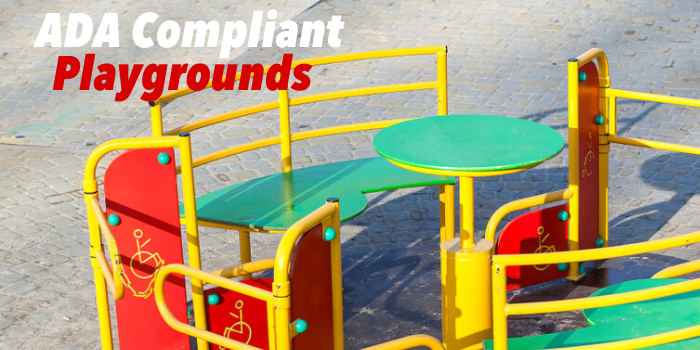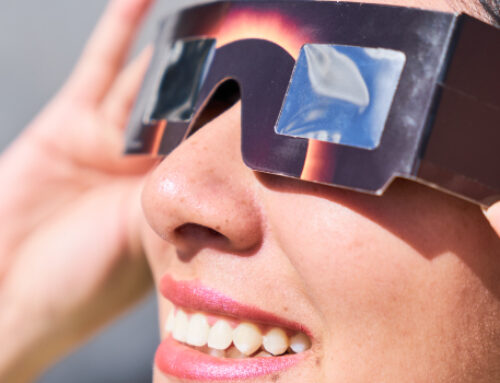Most common playground activities involve sliding, climbing, swinging, and other physical activities. It is difficult to build a playground that is accessible for all, including children with special needs. However, it is important to create an enjoyable and safe playground where all children can socialize and have fun.
Modern playground design is inclusive for all children, with the goal of creating a safe play space for children of all levels of ability to gather and engage in play. In this article, we’ll take a look at what it entails to create an inclusive playground, and we’ll show you examples of truly modern play spaces such as Morgan’s Wonderland, the first inclusive theme park in the world.
HOAs & Accessibility Laws
First, before we talk about inclusive playgrounds, let’s review the accessibility laws that could apply to the playground in your community association.
While HOAs must comply with disability accommodation and modification requirements in the federal Fair Housing Act and any state fair housing laws, the Americans with Disabilities Act (ADA) does not apply to most HOAs. This is because community associations are not typically open to the public, meaning that the HOA’s services, facilities, and common areas (including its playgrounds, parks, and pools) are exclusively used by the HOA’s members, residents, and invited guests of those members and residents. The ADA, on the other hand, applies to government services and buildings, places of public accommodation, commercial facilities, employers with 15 or more employees, and education, transportation, and telecommunications providers.
So, if an HOA opened its facilities to the public (such as by hosting public swim lessons at the community pool), has 15 or more employees, or is a mixed-used community (meaning that the association contains commercial establishments, such as restaurants and shops), the ADA would apply to that association. This is because these are ways an HOA may be considered a place of public accommodation or a commercial facility.
As housing providers, community associations are subject to applicable federal, state, and local fair housing laws, which protect those with disabilities from being denied equal access and enjoyment to their home and the community. Under the federal Fair Housing Act, which applies to HOAs throughout the U.S., an HOA would need to permit any reasonable modifications requested due to a disability (at the requestor’s expense) and make any reasonable accommodations requested due to a disability (at the HOA’s expense).
A reasonable modification refers to structural changes to either common areas or the resident’s/homeowner’s lot to make it accessible. A reasonable accommodation is a change made to a rule or service to avoid discriminating against a person with a disability.
For community associations that do fall under the ADA, any public spaces, such as a pool open to the public, a gym open to the public, restaurants, and a park that is open to the public, must be made accessible to those with disabilities. As part of the revisions made to the ADA in 2010, playground equipment or facilities constructed or altered on or after March 15, 2012, must comply with the 2010 ADA Standards for Accessible Design.
Purpose
All children want to be included and need to have a safe outlet for play. The goal of these standards is to ensure that any child aged 2 or older is given equal opportunities for play and socialization, allowing for access to play equipment by either moving out of a mobility device onto the playground structure (i.e., via transfer station), or to be able to directly access the play structure in a mobility device (i.e., via ramp).
The Basics
Let’s review the basic features of an accessible playground:
- At least one of each of the types of ground-level play equipment in the play area can be accessed by a child with a disability.
- Ramps or transfer systems are provided to at least half of the elevated structures at the play area.
- Surfaces accommodate wheelchairs.
- Surfacing under, around, or on the way to play structures acceptably cushions falls.
A play component can be defined as an element intended to generate specific opportunities for learning, play, or socialization. Play components may stand alone or be part of a composite play structure. They can be natural or manufactured.
Types of Play Components
There are two types of play components: elevated and ground-level.
An elevated play component is approached above or below grade; it is part of a play structure consisting of other play components attached or linked functionally to create an integrated unit providing more than one play activity. Elevated play component examples are double slides, tubes approached from a deck or platform, climbers, and other overhead play equipment. Elevated play components must be accessible through ramps and/or transfer systems.
A ground-level play component is approached and exited at ground level. Examples of ground level play components are swings, sandboxes, spring rockers, and educational toys.
Accessible Routes
An accessible route is defined by the Americans with Disabilities Act Accessibility Guidelines as “a continuous unobstructed path connecting all accessible elements and spaces of a building or facility.”
Accessible vs. Inclusive
One common misconception is that an accessible playground is also an inclusive playground. However, an accessible playground is not always inclusive for children of all physical and mental abilities!
While an accessible playground allows for physical access, an inclusive playground is one that enables both physically disabled and non-disabled children to engage in play. By designing play equipment to meet the needs of children in wheelchairs, as well as those who are sight-impaired or have autism, for example, “special needs” sections are eliminated because all equipment is designed to challenge and engage all children without stigmatization or segregation.
Examples of inclusive play may include a fence to protect children from running into nearby traffic, a path to the play area which allows children to watch the action and adapt before entering a situation for play and engagement, or special surfacing that prevents falls for those on crutches.
How to Incorporate Inclusive Playground Equipment
Going beyond accessibility, inclusive playgrounds are recreation and play spaces that address the needs of the whole child. Inclusive playgrounds include every child; they encourage children of all abilities to experience the benefits of play . . . together.
An inclusive playground includes the following elements:
- Access: Any child (or parent) can access the play space, regardless of their ability.
- Engagement: The playground is attractive and engaging; it includes movement, textures, colors, and sound.
- Cognitive Development: Interactive boards, swinging, climbing, rocking, etc., are incorporated to bring learning into the play experience.
- Comfort: A mix of active and quiet play areas should be incorporated to provide space for children who may be overstimulated by crowds.
Is Your HOA Playground Inclusive?
Now that you’ve reviewed the information above, you may be wondering if your HOA’s playground is inclusive.
A comprehensive checklist for Public Playground Accessibility Review is available here. For the full guide, please visit the United States Access Board.
It’s understood that recess and playtime are very important to a child’s development. Playtime develops social and motor skills, symbolic thinking, and furthers language development. By incorporating universal design principles into your community’s playground, the association board will enable the HOA to exceed ADA guidelines, whether or not they are required to follow them, thereby creating a fun and safe play environment for each child, no matter their ability.
As awareness for children’s needs grows, more inclusive parks and playgrounds are being developed. For instance, Haltom City, near Fort Worth, just opened an inclusive playground so that all children in town can enjoy themselves on a variety of playground equipment. Read more about this here.
At Spectrum Association Management, we are proud to sponsor inclusion for all children by partnering with Morgan’s Wonderland in San Antonio, Texas. If you would like to learn more about examples of great inclusion for special needs children, please click here.
This article is for educational purposes only.







